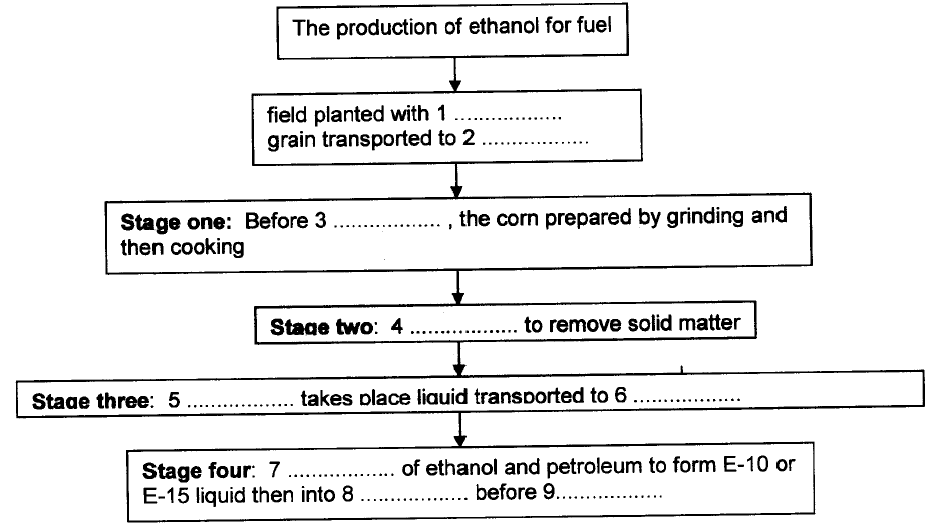Trước khi đi vào ví dụ cụ thể, chúng ta hãy xem qua các bước cần làm
Bước 1. Đọc yêu cầu đề xem được điền bao nhiêu từ vào chỗ trống, đọc tựa đề của biểu đồ và nhìn sơ qua biểu đồ để biết nó cần thông tin gì.
Bước 2. Đọc các câu hỏi, gạch dưới các từ khóa phía trước và sau chỗ trống, và đoán từ loại và nghĩa của từ cần điền vào chỗ trống.
Bước 3. Tìm các từ khóa được gạch chân ở bước 2 trong bài đọc và trả lời câu hỏi
Chú ý:
- Số lượng từ cần điền + ngữ pháp của các từ xung quanh (ví dụ danh từ trong bài số nhiều mà bạn điền số ít vào chỗ trống là sai, hoặc nếu các từ trong các phần chú giải khác của biểu đồ có dùng mạo từ theo đúng luật ngữ pháp thì bạn cần lấy luôn mạo từ trong bài đưa vào câu trả lời miễn nằm trong giới hạn số từ cho phép được điền).
- Các từ chỉ trình tự (first, next, subsequently = after that = then…) với biểu đồ trình tự làm việc gì đó + các mô tả vị trí trên dưới, trái phải, trước sau để biết vị trí của các bộ phận được mô tả trong biểu đồ cấu tạo máy móc.
Hãy thử làm các bài tập sau:
EXERCISE 1
Complete the following diagram using NO MORE THAN THREE WORDS from the text above for each answer.

- Từ khóa câu 1: appearance of…underside leaves, câu 2: rust on, câu 3: berries, câu 4: falling prematurely, câu 5: twigs become, câu 6: starving roots caused by, câu 7: number of… reduced
Các bạn hãy đọc đoạn văn sau và trả lời các câu hỏi 1-7.
Under British rule, the island of Ceylon was stripped of its forests to turn over every available acre to coffee production. By the 1870s, Ceylon was exporting nearly 100 million pounds of coffee a year, much of it to England. This empire, however, was swiftly devastated by the arrival of the coffee rust fungus. The rust organism can be recognized by the presence of yellowish powdery lesions on the undersides of the leaves of the coffee plant. Occasionally green shoots and even the green coffee berries can be infected. The infected leaves drop prematurely, leaving long expanses of bare twigs. This defoliation causes shoots and roots to starve and consequently to die back, reducing the number of nodes on which coffee can be produced the following season.
EXERCISE 2:
Thomas Newcomen’s steam engine was one of the first machines to use the power of steam for mechanical work. It was originally used to pump water from mines. There is a boiler over a coal fire which makes steam. This drives the piston in the open top cylinder above the boiler. When the amount of steam increases, the pressure opens the valve, allowing the steam to fill the cylinder and push the piston up. When the piston reaches the top of the cylinder, the first valve is closed and the second valve opens. This second valve sprays cold water into the cylinder from the water tank, condensing the steam and creating a vacuum. The air-pressure from the open-top cylinder pushes the piston down again, pulling the rod down with it. Then the cycle repeats itself all over again.
Label the diagram using no more than TWO words from the passage.

EXERCISE 3
Complete the flowchart, using NO MORE THAN TWO WORDS in the passage
The production of fuel-ethanol or ‘grain spirit’ from grain is relatively straightforward. It is made from harvested crops. As the demand for alternative ‘clean’ fuels increases, farmers are switching for planting crops for consumption to fuel crops like corn, barely, wheat, or others that produce oil like palm oil and rape seed. The growing process is no different from that of any crop. A farmer simply plants a field of corn, which is then harvested. Instead of being taken to a mill to produce flour, the corn is delivered by lorry to a distillery where it goes through four main stages before it can be used as fuel. First, during a preparation phase, the grain is ground then cooked prior to the fermentation process commencing. Then, before the distillation of the liquid to produce the ethanol takes place, solid matter has to be removed by filtration. At a fuel-ethanol plant, the blending of ethanol and petroleum is carried out to produce E-10, a mix of 10 per cent ethanol and 90 per cent petroleum, or E-15, which is 15 per cent ethanol and 85 per cent petroleum. The liquid is then put into storage and the distribution process is ready to begin.


Phần thứ 3… câu 2
Đáp án không phải là a mill mà là a distillery do chữ instead of (thay vì) nên grain có nghĩa là hột sau khi được thu hoạch
Thank bạn đã góp ý. Đã sửa nhé
Hay